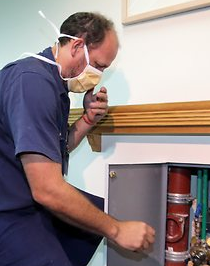A preliminary analysis
There was an outbreak of Legionnaire’s disease from the hot water system at the Wesley Hospital in Brisbane. One patient has died and another is seriously ill. There is a legal requirement for the outbreak to be reported immediately to the Health Department, but this was not done by either the Hospital or the Pathology laboratory, citing an IT failure. This excuse is not acceptable.
From an occupational hygiene perspective, what is interesting is the way in which the Hospital is responding, particularly in its use of respiratory protection.
 It is essential that P2 (N95) particulate face masks are provided and properly fitted. A new bulletin on SBS One News (7 June 2013) showed an unshaven plumber wearing a face mask that appeared to be a surgical mask with one set of the straps dangling. A similar picture in the Courier Mail shows “Wesley Hospital staff flush pipes and check water temperatures “. In this picture the person is again appears to be wearing a surgical masks and only one strap is done up. Facial growth is clearly evident. Wrong mask, bad fit and almost no protection for the wearer.
It is essential that P2 (N95) particulate face masks are provided and properly fitted. A new bulletin on SBS One News (7 June 2013) showed an unshaven plumber wearing a face mask that appeared to be a surgical mask with one set of the straps dangling. A similar picture in the Courier Mail shows “Wesley Hospital staff flush pipes and check water temperatures “. In this picture the person is again appears to be wearing a surgical masks and only one strap is done up. Facial growth is clearly evident. Wrong mask, bad fit and almost no protection for the wearer.
The use of surgical masks for respiratory protection is very common in healthcare and indicates major cultural and technical issues in managing OH&S.
Much of the problem must lie in the design of the hot water system. Obviously there is a patient safety issue when the temperature is required to be blow that which kills the bacterium. This requires better design, better maintenance and verification by monitoring that the controls are working. It appears that the hospital has failed in all three counts.
In disinfecting the system, the obvious first stage is to raise the water temperature to a level that will ensure disinfection of the furthest point in the system and to run the hotter water through the system to ensure this temperature is reached for a sufficient time to be effective.
In running hot water through the system, it is necessary to prevent the generation of aerosols at taps and showers. Ideally shower heads should be removed and a tube attached to lead the water to the drain in such a way as to minimise aerosols. The shower head would then be disinfected with hot water and chemicals. It is known that show heads provide a good reservoir for the bacterium and it is well known that the risk in using an infected shower is greater for the first person than the second.
One of the other important aspects of the project is to properly identify dead end and legs in the system and remove them, as they can act as reservoirs. It is not known whether simple hot water treatment of the system will suffice to minimise the problem.
If the Wesley hospital is getting it so wrong with reporting the outbreak and protecting its staff dealing with the outbreak, one should have great concerns about whether they are able to properly control the outbreak.
The August 2013 edition of Applied Occupational and Environmental Hygiene has a commentary “The Use of Respirators to Reduce Inhalation of Airborne Biological Agents” by Janssen et al.
Their conclusions support my views:
- The “respirators versus surgical mask” debate is complex and remains hotly debated
- Because there are no requirements for small particle ?ltration ef?ciency or ?t for surgical masks, they should not be expected to provide respiratory protection
- If particle inhalation is a signi?cant route of exposure for that aerosol, filtering facepiece respirators [ie industrial P2 face masks] are far more likely to reduce infection via this route than are surgical masks.
